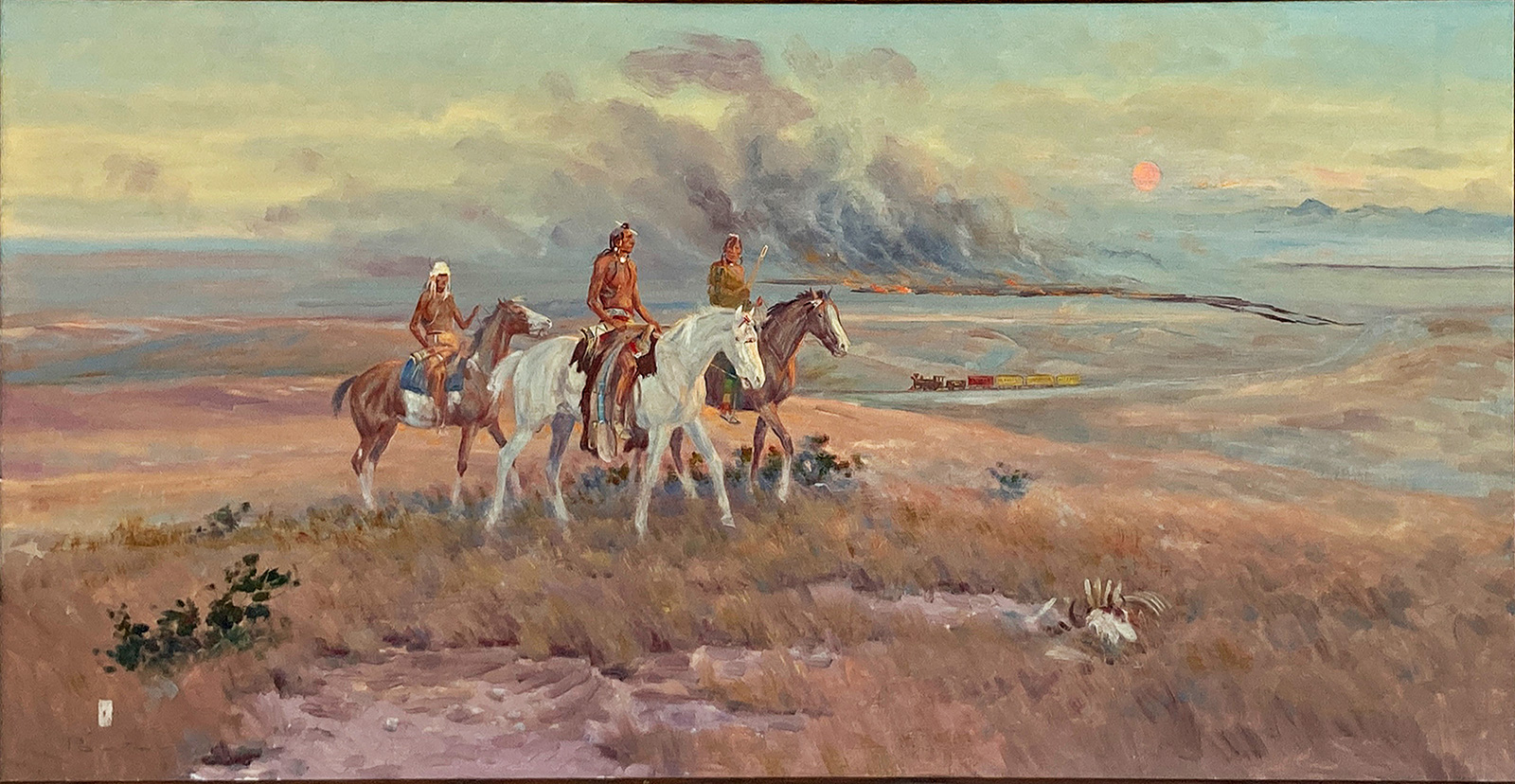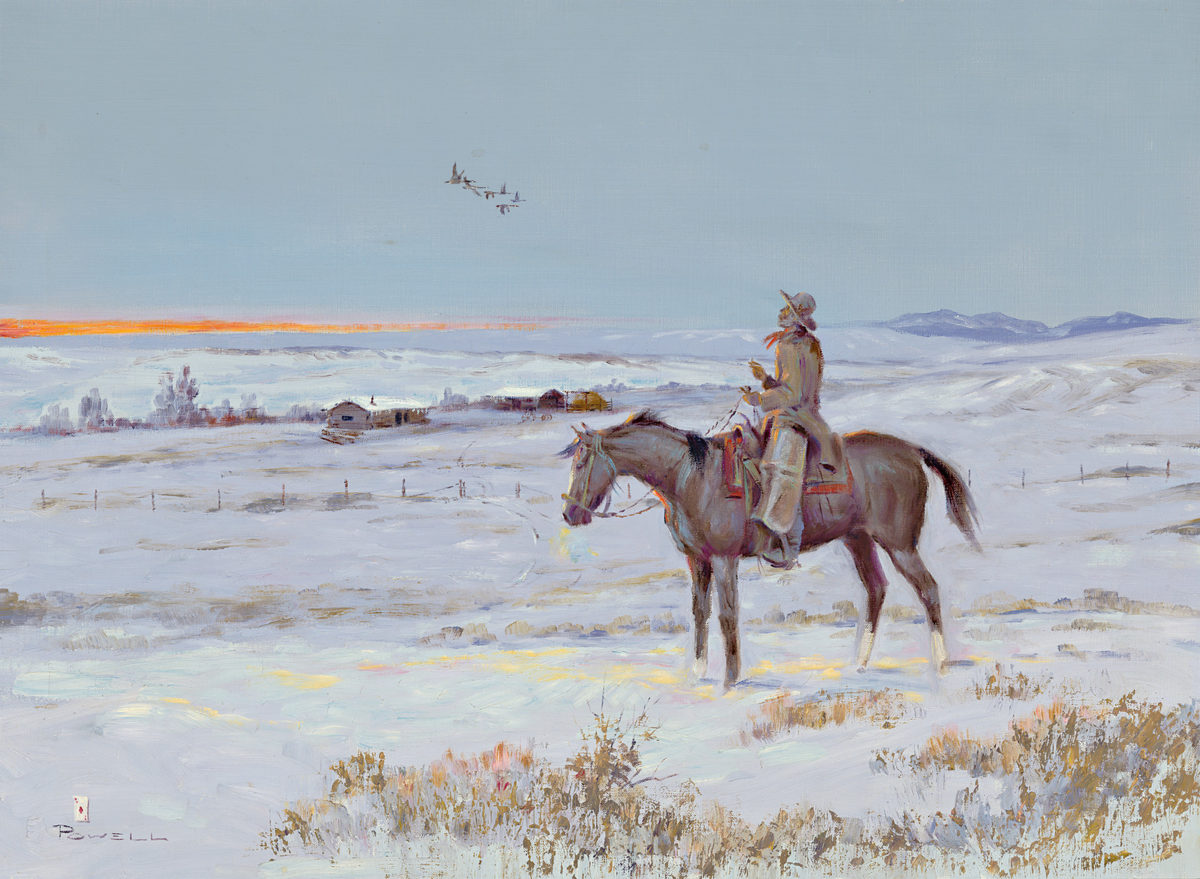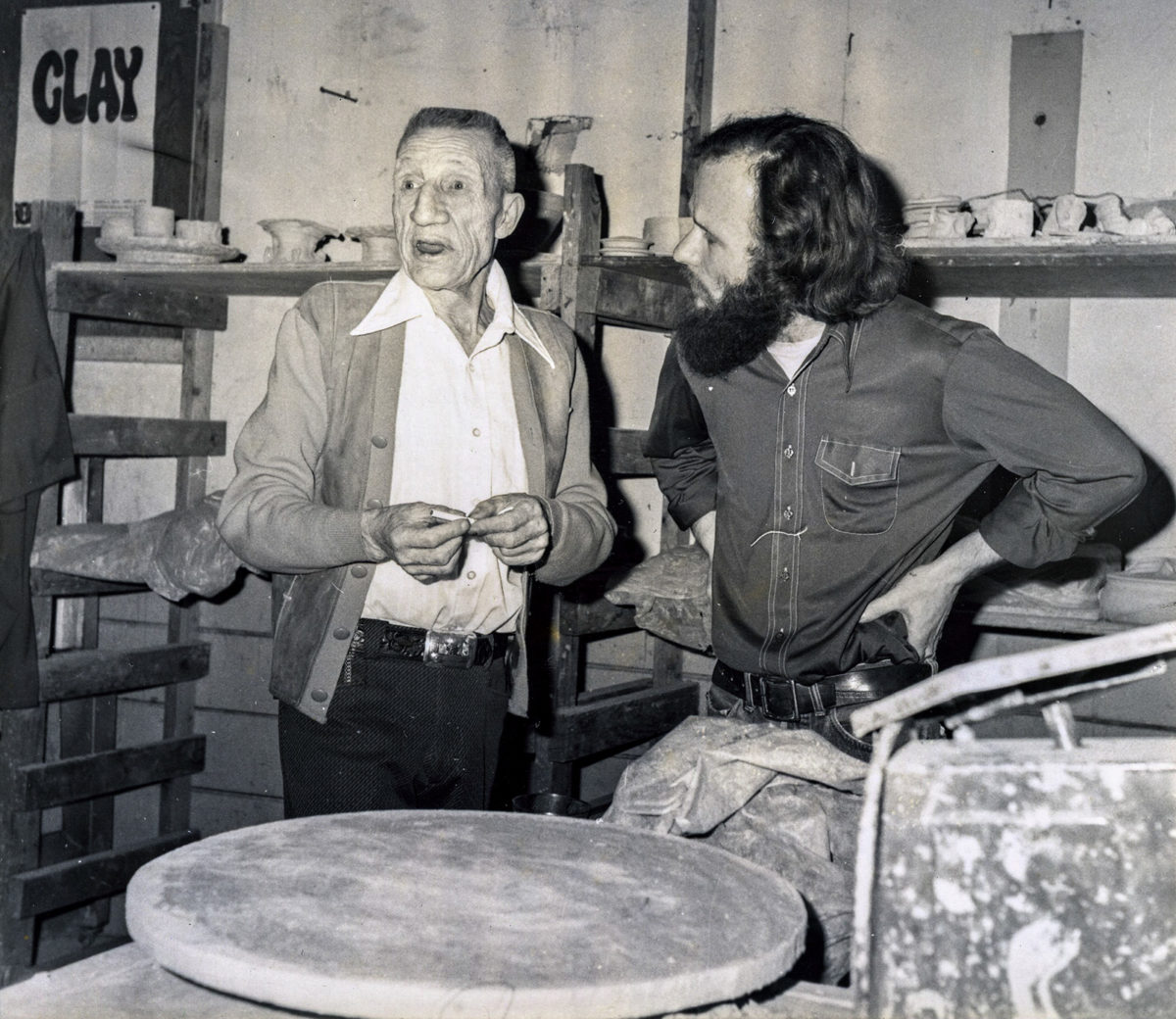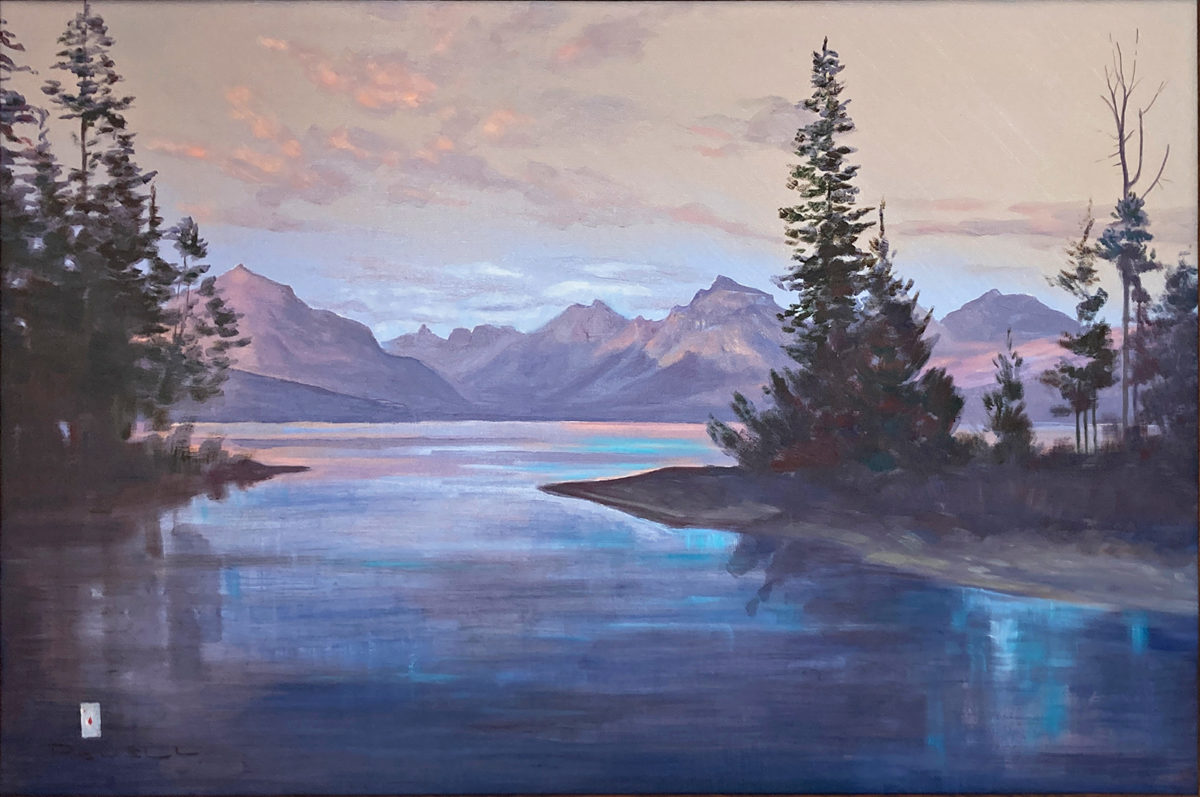Ace Powell’s Last Painting, and Enduring Legacy
Recent bequest of six paintings from private collection to the Hockaday includes a piece believed to be the final one the legendary artist completed
By Myers Reece
In the late 1950s, when DuWayne Steiner was one of two drivers of the Great Northern Railway “bruck” now permanently on display at the Whitefish train depot, he bumped into Ace Powell at a bar one evening in West Glacier.
“We were both known to take an occasional drink,” Steiner, now 94 years old, recalled recently from his home in Conrad.
In the ensuing years, Steiner developed a friendship with Powell, who was at the vanguard of the Western art movement while cementing a formidable legacy that endures today. But it wasn’t until 1971 that Steiner purchased his first Powell piece, followed by a commission request for the artist to recreate in oil a 1907 black-and-white photo of Lake McDonald.
Fifty years later, those first two paintings — “Dead Headin’” and “Sunset on Lake McDonald” — are among six that Steiner has bequeathed to the Hockaday Museum of Art in Kalispell, including one believed to be Powell’s last: a 24-by-48-inch piece called “Prairie Fire,” completed several months before the artist passed away in 1978.
“I wish he could have done more but I’m thankful for the ones he did get done,” Steiner said. “I got to be a good friend of his, and I want to leave what I have at Hockaday and keep Ace Powell alive.”
Hockaday Executive Director Alyssa Cordova calls Powell “our local Charlie Russell,” while renowned landscape painter Mark Ogle said Powell was a pivotal figure in establishing the modern Western art scene as a viable and respected career path for fine artists.
“There’s just a myriad of people that Ace influenced, including myself,” Ogle said. “Ace was really a linchpin around here for the arts.”
Cordova said Steiner wanted the Powell pieces in his private collection to return to Kalispell even though he no longer lives in the area.
“They’re significant works and he wanted to make sure the public could enjoy them here,” Cordova said.

The bequest was recently finalized, and the museum is planning a Powell showcase once it brings the works into its possession, although Steiner isn’t quite ready to let go of them yet.
“He wants to keep them with him until his last breath,” Cordova said. “His home is literally covered in Ace Powell art, and he gets so much enjoyment by sitting and looking at them all day.”
The six paintings have been lovingly cared for but nevertheless hidden away from the public eye for decades, enjoyed by Steiner, his wife Pam and their visitors.
“It’s amazing when you meet collectors like DuWayne, pulling up to this unassuming house out in the country in Conrad, and you walk in and it’s just full of all this artwork,” Cordova said. “It’s amazing.”
Cordova said the more she has researched Powell and his legacy, the more she has realized how significant the Steiners’ bequest is for the local community and broader Western art world.
“When art goes to a private collector or auction, people never get to see it unless you happen to know that person and get invited to their home,” she said. “By bequeathing the work to a museum, it gives an opportunity for the work to be on view for the public and for school tours and for educational purposes. We’re really grateful he selected the Hockaday.”
Ogle met Powell in the late 1960s as a high school junior when he started working at the artist’s Kalispell bronze foundry, operated by Powell’s son Eddy. In addition to the foundry, Ogle, an aspiring artist, would regularly visit Powell’s studio on the southern end of downtown Kalispell.
“I never took lessons from Ace, but I just watched him paint and learned,” Ogle said.
“Ace told me his goal was to create an art mecca in the Flathead Valley, to assemble enough professional artists that people would actually fly in or drive in to purchase art,” Ogle added. “He wanted to leave that as a legacy. I never forgot that. I kind of carried that on. And he achieved that goal. This area has populated itself with professional artists and it’s because of Ace’s imprint on this area.”
Ogle says Powell helped launch the careers of a generation of gallery operators and art dealers such as Bernie Kushner, Paul Mesa and Van Kirke Nelson, while bringing in some of the area’s most famous artists, including Joe Abbrescia and Robert Cavanaugh.
“All these artists moved to this area, and I attribute that to the magnetism of Ace Powell, absolutely attribute it to Ace,” Ogle said.

In addition to attracting big-name artists, Powell was committed to mentoring younger artists, according to his son Dave Powell, also an artist who lives in Illinois. The 70s catalyzed the modern Western art movement, led by a new middle class with disposable income and an interest in paintings depicting cowboys, Native Americans, wildlife and landscapes, as well as an upper class with even more money to throw at art, including a proliferation of Texas oil millionaires, Ogle said.
In Northwest Montana, Abbrescia and Powell were leading the way.
“It was a chain reaction and it’s still going to this day because of people like Joe Abressica and my dad,” Dave Powell said. “I think it helped build a bedrock in the community in Montana at the time and really gave a strata to work from so contemporary art could be shown and really have a good base.”
Joe Abbrescia, Jr. runs an art restoration business and gallery in downtown Kalispell. He said his father, who is considered one of the 20th century’s preeminent American impressionist and plein-air painters, was in Chicago when he took note of Powell’s work. He told Kushner, who ran Ace Powell Gallery in Kalispell, “he’s making those skies up; they can’t be real.”
“Bernie said, ‘Come out to Montana and see. We have skies like that,’” Abbrescia, Jr. said.
So Abbrescia came out to Montana, where he became close friends with Powell, “constantly sharing ideas about painting,” according to Abbrescia, Jr., who remembers Powell as perpetually having a cigarette in his lips or hand. He also remembers Powell as being extremely prolific, producing upwards of 12,000 pieces in his career across a variety of mediums.
“That’s what was interesting about Ace, is he did a lot of mediums, not just oil but etchings, bronzes, sculptures, watercolors, pen and ink, cartoony things,” Abbrescia, Jr. said. “That’s one of the reasons that he’s still well known and still around today because he was very prolific.”
Powell was born in Tulerosa, New Mexico in 1912 and raised in Apgar at the southern end of Lake McDonald in Glacier National Park. As a boy he used to watch Charlie Russell paint at Bull Head Lodge, and the great American West artist took time to mentor the young Powell, informing his eventual decision to devote his life to art.
Powell’s childhood and early adulthood experience as a cowboy breaking and wrangling horses influenced his work, as did his experience coming to age during the Great Depression. Dave said his father took a blue-collar approach to painting, waking at 5 a.m. and painting until dinner at 7 p.m. with only periodic breaks to eat and, later in life, nap.
Moreover, Powell appealed to the working class. Dave said his father “painted for the regular folks of Montana, and he priced it that way.”
“An everyday guy could buy an Ace Powell for 20 bucks,” Dave said. “He felt that art wasn’t exclusively for the upper class. He was a working-class hero in that way.”

Dave said his dad released everything he painted, no matter the quality, letting the market decide if it was worth paying him for his labor and materials.
“You see Ace Powells that are terrific and you see Ace Powells that aren’t terrific,” Dave said.
Powell also had a high-minded sophisticated side to him, loving the work of classical artists such as Auguste Rodin, Gustav Klimt and others. And while an everyday Montanan could afford a Powell piece of some kind, his most highly sought works often ended up in private collections in Europe, Dave said.
“All the real jewels are still being held by private owners all around the world,” Dave said.
For that reason, Dave says it’s “wonderful” to see six of his dad’s significant paintings coming back into the public sphere from private collection. Dave agrees that “Prairie Fire” is likely his father’s last finished work, although he said one unfinished painting was on his dad’s easel the day he died, on Jan. 25, 1978 in Kalispell. He anticipates more pieces emerging from private collections in the future.
“They’re going to be coming out of the woodworks for generations to come,” he said.
Three days after Powell’s death, the Daily Inter Lake ran a series across three pages dedicated to the artist. One story quoted Powell as saying “prairie grass has the quality to be as beautiful as a rose garden in different lighting,” while also calling death the “last greatest event of my life.”
In another tribute, Powell’s longtime friend and famed Browning sculptor Bob Scriver said “every place Ace went an art community would spring up.”
“You can follow his trail from Choteau to Browning to Hungry Horse to Kalispell,” Scriver said. “There would be no art in a community until Ace arrived and then it would become an art community.”
The Ace Powell Memorial Award was established after the artist’s death, and the award’s first recipient was Ogle.
“Because of the influence of the Powells on my life, it was quite an honor to receive that award,” Ogle said.
Among Ogle’s many memories of Powell, he recalls the crowds that would form around him at major art shows, everybody hoping to speak to the legendary artist.
“Because Ace was so influential in these art shows, other artists around the Western part of the country not only knew who Ace was but they emulated Ace,” Ogle said. “And because he started so many dealers in the Western art movement, I think that branched off to the whole West to some degree. He truly was the linchpin.”